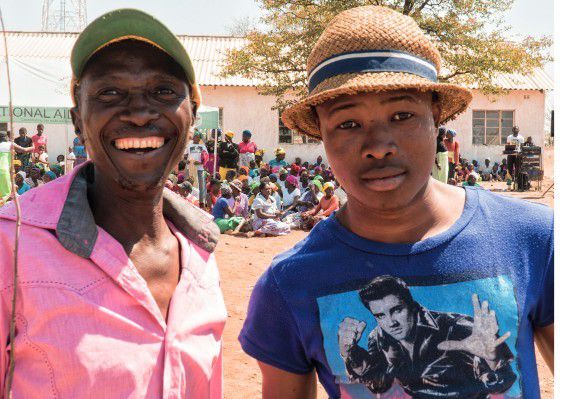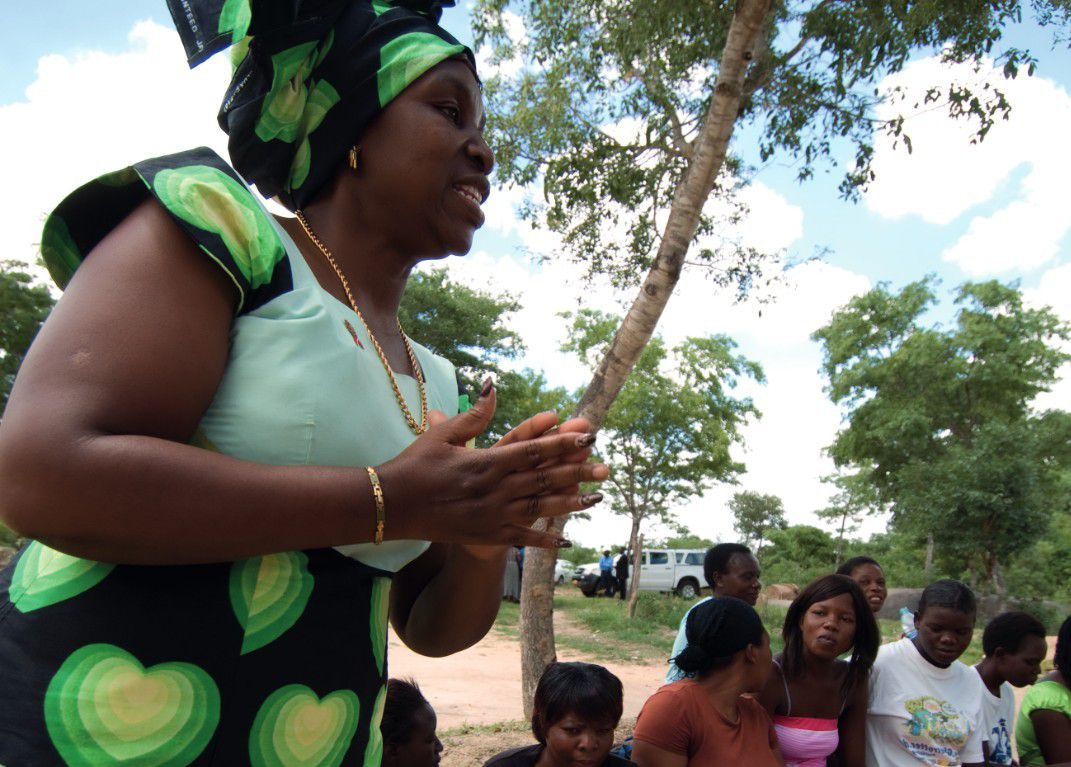Guiding Principles
.jpg)
Communications Strategic Objective 1
Increase knowledge and change attitudes and perceptions about the specific needs of key and vulnerable populations in order to advocate for a more enabling environment for seeking HIV prevention, care, and treatment services. Increase knowledge and change attitudes and perceptions about the specific needs of key and vulnerable populations in or der to advocate for a mor e enabling environment for seeking HIV pr evention, care, and treatment services..
Dissemination
1. Develop information toolkit for policymakers and media bodies. 2. Engage with policymakers and media bodies to discuss key and vulnerable populations.. 3. Develop policies to inform providers about key and vulnerable populations, such as, including KP provider training in mentorship curriculum. 1. Percentage of respondents who report that they are
more aware of the specific needs of key and vulnerable
populations seeking HIV prevention, care and treatment
services. 2. Percentage of policymakers/media bodies reached with
messages/campaigns on the specific needs of vulnerable
populations who then advocate for the needs of
vulnerable populations. 3.Number of guidelines/regulations/policies developed/
amended to improve the enabling environment of
vulnerable populations accessing HIV prevention, care and
treatment services.
...
Systems and Structures: Addresses rules, regulations or processes that impact
communications delivery.
Communications Strategic Objective 1:
Key Activities
Illustrative Indicators
.jpg)
Communications Strategic Objective 2
Advocate for comprehensive and integrated HIV communications approaches and messages across implementing partners, funders and government agencies. Due to the new comprehensive approach to HIV communications, the focus of this objective is to popularize and promote the use Advocate for comprehensive and integrated HIV communications approaches and messages across implementing partners, funders and government agencies.Due to the new comprehensive approach to HIV communications, the focus of this objective is to popularise and promote the use of this strategy, including branding the strategy itself.
Dissemination
1. Create a brand (logo and identity) for the Comprehensive National HIV Communications Strategy. 2. Post strategy to Ministry of Health and Child Care website and partner websites. 3. Present strategy at National AIDS Council meetings. 4. Develop a standardised presentation for quarterly Provincial Health Team and District Health Team meetings, Prevention Partnership Forum, PMTCT Partnership Forum, Treatment and Care Partnership Forum and Adolescent SRH Forum. 5. Orient health promotion officers and district health officers to cascade the strategy throughout the provinces and districts. 6. Develop a media kit and press release and hold a press conference. 7. Deliver strategy outside health agencies, including to other ministries, religious groups, chiefs’ councils and parliament for better collaboration.
Implementation
1. Develop communications materials (including formats for PWD) for field offices, and train community members and providers. 2. Develop an interactive mobile app/microsite. 3. Develop a sensitisation presentation on using the strategy for different levels and a standardised approach to help partners develop and align plans with the strategy. 4. Develop a mechanism to monitor and ensure compliance of the comprehensive communications strategy. 1. Number of advocacy campaigns on comprehensive HIV and SRH communications approaches conducted (disaggregated by geography, national/provincial/district, type of audience [implementing partner, funders, government agencies]). 2. Number of advocacy tools developed to increase the use of comprehensive HIV and SRH communications approaches. 3. Percentage of target audience who report using comprehensive HIV and SRH communications approaches to increase uptake of HIV prevention, care and treatment services. 4. Percentage of policymakers/media bodies reached with messages/campaigns on the specific needs of vulnerable populations who then advocate for the needs of vulnerable populations. 5. Number of guidelines/regulations/policies developed/amended to improve the enabling environment of vulnerable populations accessing HIV prevention, care and treatment services.
...
Systems and Structures: Addresses rules, regulations or processes that impact
communications delivery.
Communications Strategic Objective 2:
Key Activities
Illustrative Indicators

Communications Strategic Objective 3
Enlist support from providers and health care workers, traditional, religious and community leaders, to be change agents in their communities for communication of HIV prevention, care, and treatment services. Enlist support from providers and health care workers, traditional, religious and community leaders, to be change agents in their communities for communication of HIV prevention, care, and treatment services. 1. Map religious and traditional bodies to prioritise interventions based on geographic distribution, information gaps, population needs, doctrine, etc. a. Establish calendar, membership and mandate of existing religious bodies and incorporate interventions into agenda of their regular meetings. 2. Develop sector-specific comprehensive information toolkit through a consultative process for distribution with communities. 3. Disseminate the toolkit. 4. Train providers on client-centred care for each and every client, regardless of sexual orientation, religious beliefs, level of ability, age, gender or profession. 1. Number of providers, health care workers as well as traditional, religious and community leaders who participate in HIV comprehensive communications activities at community level. 2. Percentage of providers and traditional, religious and community leaders who express accepting attitudes around community members accessing HIV prevention, care and treatment services.
...
Culture and Community: Addresses key influencers in local institutions, support systems
and formal and informal networks that impact information and communications delivery.
Communications Strategic Objective 3:
Key Activities
Illustrative Indicators
.jpg)
Communications Strategic Objective 4
Deliver messaging and communications approaches that align with the journey of HIV prevention, care, and treatment for targeted audiences. Since this is an overarching strategy document, detailed activities targeting specific audiences Deliver messaging and communications approaches that align with the journey of HIV prevention, care, and treatment for targeted audiences. Since this is an overarching strategy document, detailed activities targeting specific audiences and programmes will be left for implementers to assign as funding allows. The following activities apply to all target audiences across HIV programmes. 1. Conduct targeted outreach campaigns that will assist in finding those who do not routinely intersect with medical systems, such as key populations, young men and young women. Targeted outreaches must reach into the communities efficiently to find these population groups. The targeted outreaches will include: a. Moonlight outreaches targeting key populations, adult men and women, young men and women. These outreaches will be performed every quarter. b. Conduct specific outreaches that align with calendar events such as World AIDS Day and school holidays. 2. Hold peer-to-peer dialogue/conversations with communities and leaders. a. These general dialogues will be held within communities/districts whereby all target audiences may be present. Thus, dialogues will be tailored to comprehensive HIV prevention, care and treatment issues and be performed every quarter across all districts. 3. Develop highly targeted communications material to appeal to selected audiences a. Communications material will be developed covering HIV prevention, care, and treatment services that are available for all populations. However, design and content will vary according to the target population. IEC materials will be highly targeted, especially for key and vulnerable populations, to ensure visuals and content reflect the target audience as closely as possible. i. Conduct multimedia campaigns targeting AGYW, KPs, and other vulnerable populations b. Use a long-format, storytelling approach to address deep-seated social and behavioral norms. c. Develop radio campaigns featuring dramas and talk shows: i. Testimonials highlighting expert client experiences ii. Stigma-reduction messages for vulnerable populations d. Develop social media campaigns (including video, memes, etc.) featuring dramas: i. Testimonials highlighting expert client experiences ii. Stigma-reduction for vulnerable populations 1. Percentage of target audience with accurate knowledge of HIV prevention methods (condoms, PrEP, VMMC) and benefits 2. Percentage of target audience who know where to access a) HIV testing services, b) condoms, c) PrEP, d) VMMC, e) ART, f) SRH services 3. Percentage of target audience who know how to use condoms consistently and correctly 4. Percentage of community members expressing accepting attitudes of adolescents accessing HIV and SRH services 5. Percentage of target audience expressing self-efficacy for accessing health services 6. Percentage of target audience who are satisfied with provider health service delivery 7. Number of people exposed to HIV and SRH health awareness messages/campaigns
...
Individual Practices: Addresses key characteristics of the individual person that impact behavior
change.
Communications Strategic Objective 4:
Key Activities
Illustrative Indicators
